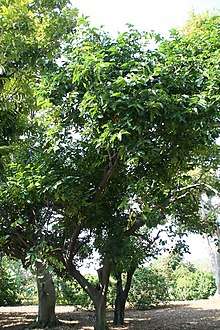Diospyros maritima
Diospyros maritima (commonly known as the Malaysian persimmon,[3] broadleaf ebony and sea ebony[4]) is a tree in the family Ebenaceae. The specific epithet maritima means "by the sea", referring to the tree's habitat.[5]
| Diospyros maritima | |
|---|---|
 | |
| At Fairchild Tropical Botanic Garden, Miami | |
| Scientific classification | |
| Kingdom: | Plantae |
| Clade: | Tracheophytes |
| Clade: | Angiosperms |
| Clade: | Eudicots |
| Clade: | Asterids |
| Order: | Ericales |
| Family: | Ebenaceae |
| Genus: | Diospyros |
| Species: | D. maritima |
| Binomial name | |
| Diospyros maritima | |
| Synonyms[2] | |
Description
Diospyros maritima grows up to 15 metres (50 ft) tall. The inflorescences bear up to 10 flowers. The fruits are round, up to 1.7 cm (1 in) in diameter.[5]
Distribution and habitat
Diospyros maritima is native to an area from Japan and Taiwan to Malesia and northern Australia.[1] Its habitat is coastal forests.[5]
gollark: Wait, what do you mean "the" C quine?
gollark: A bijection could be made between you and an arbitrarily large quantity of nanoscale bees.
gollark: Interesting.
gollark: You are like GTech's Antimemetics Division™.
gollark: Utter peristalsis.
References
- Botanic Gardens Conservation International (BGCI) & IUCN SSC Global Tree Specialist Group (2019). "Diospyros maritima". IUCN Red List of Threatened Species. 2019: e.T173957A145369887. Retrieved 16 July 2020.
- "Diospyros maritima". World Checklist of Selected Plant Families (WCSP). Royal Botanic Gardens, Kew. Retrieved 16 July 2020.
- "Diospyros maritima". Natural Resources Conservation Service PLANTS Database. USDA. Retrieved 16 July 2020.
- "Diospyros maritima". Germplasm Resources Information Network (GRIN). Agricultural Research Service (ARS), United States Department of Agriculture (USDA). Retrieved 16 July 2020.
- Ng, Francis S.P. (April 2002). "Diospyros maritima Blume". In Soepadmo, E.; Saw, L. G.; Chung, R. C. K. (eds.). Tree Flora of Sabah and Sarawak. (free online from the publisher, lesser resolution scan PDF versions). 4. Forest Research Institute Malaysia. p. 76. ISBN 983-2181-27-5. Archived from the original (PDF) on 27 September 2013. Retrieved 18 January 2014.
This article is issued from Wikipedia. The text is licensed under Creative Commons - Attribution - Sharealike. Additional terms may apply for the media files.
